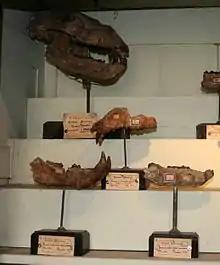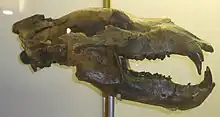| Ursus etruscus Temporal range: | |
|---|---|
 | |
| Fossils | |
| Scientific classification | |
| Domain: | Eukaryota |
| Kingdom: | Animalia |
| Phylum: | Chordata |
| Class: | Mammalia |
| Order: | Carnivora |
| Family: | Ursidae |
| Genus: | Ursus |
| Species: | †U. etruscus |
| Binomial name | |
| †Ursus etruscus Cuvier, 1823 | |
Ursus etruscus (the Etruscan bear) is an extinct species of bear, endemic to Europe, Asia and North Africa during the Pliocene through Pleistocene, living from ~5.3 million to 100,000 years ago.

Taxonomy
Ursus etruscus appears to have evolved from Ursus minimus and gave rise to the modern brown bear, Ursus arctos, and the extinct cave bear, Ursus spelaeus.[1] The range of Ursus etruscus was mostly limited to continental Europe, with specimens also recovered in the Great Steppe region of Eurasia. Fossil evidence for Ursus etruscus was recovered in Palestine, Croatia, and Tuscany, Italy.
Some scientists have proposed that the early, small variety of U. etruscus of the middle Villafranchian era survives in the form of the modern Asian black bear.[2]
Morphology
Not unlike the brown bears of Europe in size, it had a full complement of premolars, a trait carried from the genus Ursavus.
Fossil distribution
Sites and specimen ages:
- Vassiloudi, Macedonia Greece ~5.3–1.8 Ma.
- Obigarm, Tajikistan ~5.3–1.8 Ma.
- Ahl al Oughlam, Morocco ~3.6–1.8 Ma.
- Pardines, Auvergne, France ~2.5–1.8 Ma.
- Dmanisi, Georgia ~1.8–0.8 Ma.
- Mestas de Con, Cangas de Onis, Asturias, Spain ~1.8–0.1 Ma.[3]
- Strmica, Croatia ~1.8–0.1 Ma.[4]
References
- ↑ de Torres Pérez-Hidalgo, Trinidad José (1992). "The European descendants of Ursus etruscus C. Cuvier (Mammalia, Carnivora, Ursidae)". Boletín del Instituto Geológico y minero de España. 103 (4): 632–642.
- ↑ Herrero, Stephen (6–9 November 1970). "Aspects of evolution and adaptation in American black bears (Ursus americanus Pallas) and brown and grizzly bears (U. arctos Linné) of North America" (PDF). Bears: Their Biology and Management. Second International Conference on Bear Research and Management. IUCN Publications New Series no. 23. Vol. 2. Calgary, Alberta, Canada: International Association for Bear Research and Management (published 1972). pp. 221–231. doi:10.2307/3872586. JSTOR 3872586. Retrieved 12 December 2020.
- ↑ "Mestas de Con". Paleobiology Database. Cangas de Onis collection. collection list 49211.
- ↑ "Tiglian fauna". Paleobiology Database. Strmica collection. collection list 40502. sediments containing Early Pleistocene or Tiglian fauna.
Further reading
- Hanni, Catherine; Laudet, Vincent; Stehelin, Dominique; Taberleto, Pierre (December 1994). "Tracking the origins of the cave bear (Ursus spelaeus) by mitochondrial DNA sequencing" (PDF). Proceedings of the National Academy of Sciences of the United States of America. 91 (25): 12336–12340. Bibcode:1994PNAS...9112336H. doi:10.1073/pnas.91.25.12336. PMC 45432. PMID 7991628. Retrieved 10 April 2021.